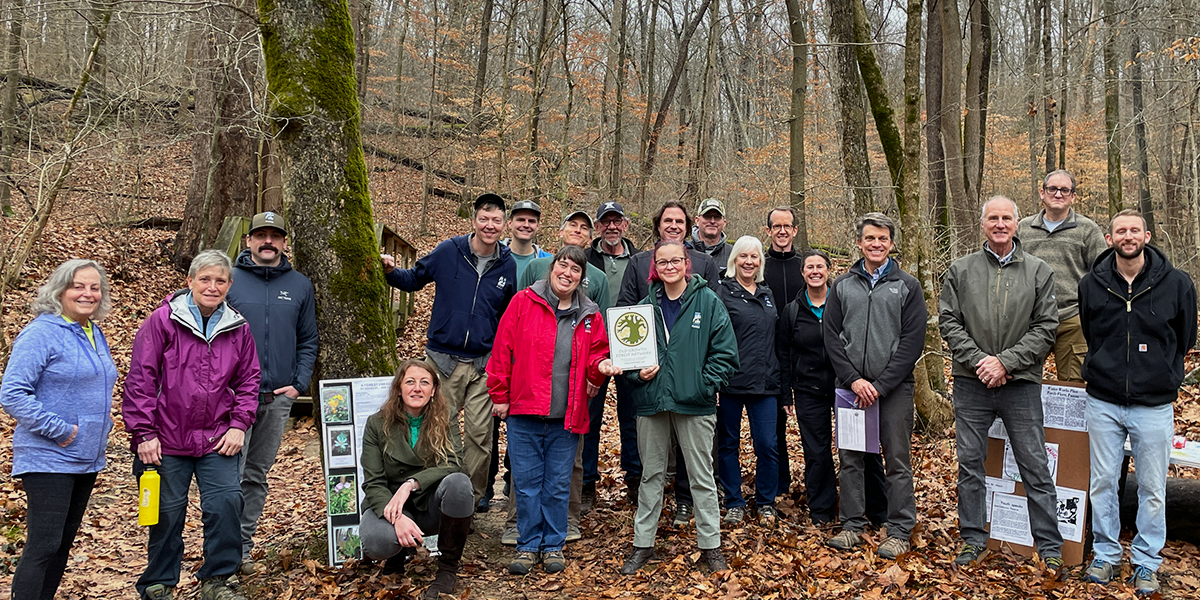California Woods inducted into the Old-Growth Forest Network
- Dec 7, 2022

Cincinnati Parks' California Woods was inducted into the Old-Growth Forest Network on Wednesday, December 7 at 2 p.m. Brian Kane, Mid-Atlantic Director of the Old-Growth Forest Network, presented a plaque to Cincinnati Parks director Jason Barron and Gia Giammarinaro, head naturalist at California Woods Nature Preserve. California Woods is the 23rd old-growth forest dedicated in Ohio, and the 185th in the United States.
The forest is located on the homelands of the Myaamia and Shawnee peoples, who inhabited this region near the river for several centuries before European settlement.
California Woods is an area of approximately 50 acres of old-growth forest within the woodlands of the 113-acre California Woods Nature Preserve. The forest’s age, its protection from winds and its deep, fertile soils have allowed it to support trees of significant stature. At least two are over 150 feet tall, and at least 11 measure over 140 feet in height. Three of the forest’s trees, a bur oak, a red hickory and a yellow buckeye, are the tallest known for their species in Ohio. The forest also hosts the world’s tallest known specimens of black walnut, hackberry, chinkapin oak, and honey locust. The old growth area formerly had height champions for shagbark hickory, bitternut hickory, black cherry, and northern red oak.
In spring and early summer, abundant native wildflowers and ferns carpet most of the forest, including many drooping trilliums (Trillium flexipes), for which the forest’s Trillium Valley is named. The forest is a haven for migratory birds that require areas of high-quality mature forest for nesting, such as yellow-throated and cerulean warblers. The forest supports several native plants that are uncommon in southwest Ohio, such as twinleaf and guyandotte beauty.
Dr. Emma Lucy Braun, a noted plant ecologist, lived near California Woods and collected many plant specimens there to illustrate her book, The Woody Plants of Ohio. Another botanist, Dr. William Bryant, Chair of the Thomas More College Biology Department in Kentucky, studied the old-growth forest and published his findings in a 1981 report. Naturalist Bert Lawson initiated and ran one of the first outdoor education programs in the nation from 1937 into the 1970s. Summer camps, school field trips, and public nature programs continue at the preserve. In 1972, thousands of school children who had experienced the nature programs here wrote letters of protest that helped stop a plan to flood 27 acres of the preserve–including part of the old growth area.
California Woods Nature Preserve features several trails that range from 1/4 mile to 1.2 miles in length. It is located at 5400 Kellogg Avenue in Cincinnati. The best access to the old growth area is from the Trillium Valley National Recreation Trail (second trailhead on the left upon entering the preserve).
The Old-Growth Forest Network (OGFN) connects people with nature by creating a national network of protected, mature, publicly accessible, native forests. OGFN intends to preserve at least one forest in every county in the U.S. that can sustain a forest. OGFN works to identify forests for the Network, ensure their protection from logging, and inform people of the forest locations.
Founded in 2012 by Dr. Joan Maloof, the network currently has 179 forests in the Network across 32 states. California Woods will join twenty-two other Ohio forests already in the Network. OGFN also recognizes exceptional forest advocates, educates about the extraordinary ecological benefits of old-growth forests, and speaks out regarding immediate threats to specific ancient forests. Learn more at http://www.oldgrowthforest.net.
Brian Kane noted, “Ohio holds the second highest quantity of old-growth forests dedicated to the Network. With 23 forests now in the national old-growth network, Ohio shows its commitment to the preservation of old-growth forest within its boundaries as well as its support for the protection of these valuable national resources.”
Kane added, “We could not grow the old-growth network without our volunteer county coordinators, who help us with forest identification and observations. I am extremely grateful for our county coordinators throughout Ohio, who have helped us identify some of the best examples of old-growth forests in the state.”
